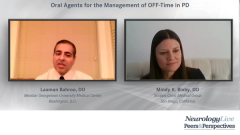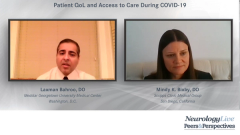
Treatments in Development for OFF Episodes in PD
Leaders in neurology discuss the development of infusion formulations of apomorphine and levodopa/carbidopa as well as oral agents with novel mechanisms of extended-release delivery.
Episodes in this series

Laxman Bahroo, DO: That brings us to future development. As your patients bring up these options in the future, let’s investigate the future a little and talk about some of the treatments that are under development. What the future truly holds I believe is moving away from the gut. If you listen to the beginning of our discussion, you can see that we’re talking about bypassing the gut for as needed, on demand therapy for OFF episodes. The question becomes if the gut is so impacted with Parkinson disease, why are we continuing to rely on oral medication? This brings us to the point of infusions. First, let’s talk about the apomorphine infusion. Dr Bixby, what do you think? How is it administered?
Mindy K. Bixby, DO: It is administered subcutaneously, so it’s noninvasive, which is wonderful. I always talk about the fact that this has been around for over 20 years and has been very effective for many patients. Some patients come to the United States and wonder why we don’t have it, and I always say, “I don’t know.” FDA approval for safety and efficacy must go through all the channels, which are important. Ultimately, if we had this opportunity, it would be amazing because it’s bypassing the gut, you don’t have to think about food, and when you’re going to eat it and how you’re going to eat it, because you have to keep it away from all these medications, quality of life is impacted. It is a subcutaneous infusion. This medication can be used over 12 or 16 hours; I’m not absolutely sure about that, I would like your thoughts. It is nice because you have a little case that carries your medications, you put in on your belt, or I’m sure there’s another apparatus to hold it on if you don’t have a belt. It’s nice because it’s like, put it on the skin, set up, a little tube, and it gives you this wonderful opportunity to feel ON frequently throughout your day. I believe that studies are coming out…almost there, hopefully, and very near in our future this will be launched, so I’m super excited about it.
Laxman Bahroo, DO: Absolutely, I hope it’s near in our future as well. Interestingly, this medication has been around in Europe for quite some time, so there’s a wealth of data as well as practices in Europe that we can easily adapt to, or co-opt for our benefit or the benefit of our patients. I think one important point is to know the TOLEDO study gave us robust data. The TOLEDO study showed us that when added, it gave you a more superior reduction than other oral medications typically do. We tend to see about a 2-hour reduction with almost any oral medication.
Here, by adding this, we were able to get a much deeper reduction and get better ON time without troublesome dyskinesia, and that’s very important to think of it that way. This tells you that this almost rivals surgical reduction of OFF time. I tend to see this as a stopgap for those patients who are at the water’s edge who are contemplating this decision. The next step, rather than surgery, would be an infusion here, so this may be an important point to consider or discuss in the future. I’m sure that because of its site of action, we must worry about some adverse effects like skin nodules. However, we have guidance from Europe as well on how to manage those, and there are some hygiene tips we have that can help us in that.
Mindy K. Bixby, DO: I think it will change our treatment of patients much more than a lot of things we’ve had in the past, simply because it’s something different, it is a different way of allowing administration of the medication. I also believe that because it’s a constant flow of infusion, that patients are going to start feeling like they can do things and be more active without the burden. Maybe a bigger thing is having…continuous opportunities to have medication all the way through, all day long. But ultimately in a small form, so they can do their run or their walk…. If they’re not able to do that because they are OFF, or they have something that’s larger for them to actually do the things they would like to do, having a small, compact opportunity for them is very much welcomed in the Parkinson community.
Laxman Bahroo, DO: Infusions are the future, not just apomorphine infusion, but there are 2 levodopa infusions that are under development. One is ND0612, which is interesting as a product, and the other is ABBV951. I’ll talk about ABBV951, which is a subcutaneous carbidopa/levodopa infusion. It’s a prodrug, so it’s phosphorylated, and that enzyme clips off the phosphate and then the medication comes in directly subcutaneously. It’s an interesting drug. It’s under study, so I don’t have as much information about this as I would for other medications that are approved and have been used in the clinic. What do you know about ND0612?
Mindy K. Bixby, DO: I know it’s also a levodopa infusion. I think we’re going into the first clinical trial. It was supposed to be launched, and proceeded in 2021; it was pushed back due to COVID-19. Once we get the first clinical trial results, I believe that will be another opportunity for patients to have an option for infusion.
Laxman Bahroo, DO: What I remember once being shown about these infusions was that they had individuals and they had measured their levodopa levels with oral pills, and you could see a spaghetti plot of all the medication doses going in every direction. Once they gave these infusions and bypassed the gut, the levels became much more stable, and not only did folks respond from a motor point of view, but even some nonmotor issues got better. I think it’s exciting to be able to talk about nondopaminergic drugs on one hand, talk about infusions on the other hand, and to be able to talk about not just motor symptoms, but nonmotor symptoms responding to infusions. We’re getting to almost the point of science fiction with Parkinson disease here. Something that was science fiction maybe 20 years ago is now coming closer, and we’re talking about much more about things that we never thought we would speak about.
Mindy K. Bixby, DO: That’d be wonderful, and what an opportunity to let patients know this is coming about; they always ask about future developments. They want to know if there’s something they can do that’s not what we have now for them. They want to know if there’s going to be a better lifestyle possibly in their future. It’s important to talk to them about the trial opportunities and say, “Hey, these are things that are happening, we’re so excited, and they’re coming about out in your lifetime,” which is wonderful as well.
Laxman Bahroo, DO: Not only are infusions there, but we also have extended-release formulations coming out. We have IPX206. Tell us about IPX206, Dr Bixby.
Mindy K. Bixby, DO: IPX066, or Rytary, is…near and dear to my heart…trials at Georgetown. It was amazing because what happened was that it changed the care of patients. They can have a controlled and immediate-release formulation that is robust, that is powerful, it allows them not to take as much medication throughout the day. That’s what I think is going to be happening more so with IPX206 because ultimately, it has been showing that it lasted longer… for the first dose, up to 10 hours. If that’s the case, it changes the face of how you’re taking care of these patients because you’re not living by these pills because it’s lasting for almost 10 hours.
Imagine taking your medication and it not being every 2 hours, or every 4 hours, or every 6 hours, you actually can take something and it works all the way through. The beauty of it is that the delivery systems are wonderful. They have immediate, they have controlled release…and so when things kick in, they get a…moment, and then when that starts to kick down, you get another wonderful opportunity for controlled release, and then that one starts to go down, then you have to do another one if you can. So for it to have a longitudinal opportunity for somebody taking the medication to last that long is amazing.
Laxman Bahroo, DO: It’s interesting because it’s going through its trials now and as mentioned, it exceeds the duration compared to the longer-acting formulation we have currently, carbidopa/levodopa extended release, which is the right target formulation, and it’s even longer acting. What’s unique is that it’s a different way to extend it, it’s a mucoadhesive, so it attaches to the gut wall and then releases the medication. It is very interesting. It’s using the gut to its favor in that sense.
Mindy K. Bixby, DO: Usually it’s the opposite.
Laxman Bahroo, DO: Exactly, the opposite.
Mindy K. Bixby, DO: The gut for patients with Parkinson disease is so frustrating sometimes. We think, “What do we do, how do we make that gut the best it can be?” Now, we’re able to use it in our favor.
Laxman Bahroo, DO: We also have the Accordion Pill, which is a gastric retention pill. The phase 2 data were promising. The phase 3 data didn’t separate from the placebo as much, so things are on hold. I’m confident there will be some way of reevaluating this, and it may be an option for individuals. The science behind it is, it’s a pill that unfolds and sits in your gut, releasing the medication, so it’s interesting.
Mindy K. Bixby, DO: I think so, too. It’s very novel how you deliver it. There’s something to it, I have a feeling that we’ll see more of that in the future in different aspects in a lot of different medications because it’s very different. I think it’s a wonderful opportunity, but we’ll see.
Laxman Bahroo, DO: Thank you for watching this NeurologyLive® Peers & Perspectives®. If you enjoyed the content, please subscribe to the e-newsletters to receive upcoming programs and other great content in your inbox.
Transcript Edited for Clarity
Newsletter
Keep your finger on the pulse of neurology—subscribe to NeurologyLive for expert interviews, new data, and breakthrough treatment updates.


































